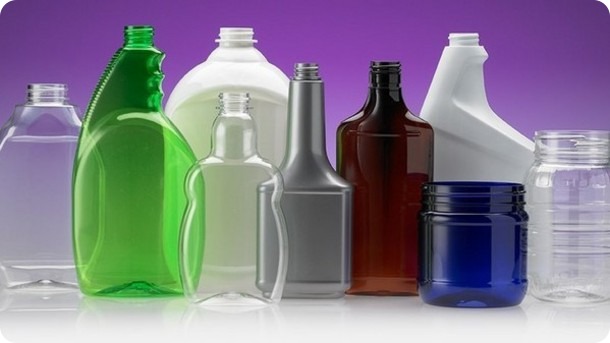PLASTIC BLOW MOLDING PROCESSES
Many commercially available processes and machines are used for plastic blow molding; each one has its advantages and limitations, as indicated in the descriptions which follow. The mold design for any given blown product will be governed by the process and machine selected. When the molder has more than one process or machine size available, the selection of the machine and mold size will be governed by various factors, including blown product size and configuration, material to be blown, production requirements, quality requirements, manufacturing cost estimates, and investment funds available. Figure 1. shows a variety of blow containers
Figure 1.
Continuous Extrusion Process
One or more hot plastic tubes (parisons) are extruded continuously at the thickness required to manufacture the blown product to the desired weight and wall thickness. During extrusion, the parison thickness may be varied (programmed)to control the uniformity of the wall thickness in the blown product. Blow-mold halves close around and pinch the parison and then must be quickly moved away from, or along with, the continuously extruding parison; the machines commercially available employ various kinds of mobile mechanisms, discussed below, to move and operate the molds.
As the mold halves are moved into position on either side of the parisons, they are sequentially closed, the parisons are pinched at both ends, and the product is blown, cooled, and removed from the machine. Generally, a secondary trimming operation is required to remove the excess plastic from both ends of the product.
The wheel machine is used primarily for high volume production of containers, in a size range of 8 ounces to 1 gallon for packaging household chemical, food and beverage, and automotive products.
Shuttle Machine. The mold halves are mounted on a mobile clamp carriage which is synchronized to shuttle the mold halves laterally, or angularly, or in an arc to the parison-extruding position. The mold halves close and pinch the parisons at the bottom end, the clamp carriage is moved to a blowing position, a blow pin is inserted into the parison,and the product is blown, cooled, and removed from the machine. Shuttle machines are available with dual mobile clamp carriages which shuttle alternately from dual blowing positions to a central parison-extruding position.
The shuttle machines are widely used because of the great variety of blown products which may be manufactured, in a size range from a few ounces to 5 gallons. Productivity can vary from a minimum on a single-parison, single-carriage machine to a maximum on a multiple-parison, dual-carriage machine.
Intermittent Extrusion Process
The intermittent process is very similar to the continuous extrusion process, except that the parisons are extruded intermittently to accommodate different kinds of operation mechanisms.
Accumulator Machine. One or more accumulating chambers are intermittently filled with material by an extruder and the material is rapidly forced from the chamber by a ram in parison form. The mold halves are in position to receive the parison as it is extruded, and they immediately close when the parison reaches the required length. While the product is being blown and cooled, the accumulating chamber is being filled again for the next molding cycle. When the product has cooled sufficiently, the mold is opened, the product removed, and another parison is extruded for the next cycle. The machines may be equipped with parison programming for wall-thick-ness control. Some machines utilize a stationary clamping mechanism,while others are equipped with single and dual mobile clamp carriages.
The accumulator machines are primarily used for the manufacture of large containers and other large products in a size range of 2xh to 800 gallons for the chemical, industrial, automotive, and toy markets.
Reciprocating-Screw Machine. Material is intermittently accumulated in the extruder barrel at the front end of the extruder screw. By reciprocation of screw, the material is forced from the barrel in the form of parisons. As in the accumulator machine, the molds are in the parison-extruding position as the parisons are extruded. Reciprocating-screw machines can be equipped to extrude 2 to 12 parisons simultaneously . They are primarily used for the manufacture of containers in a size range of 8 ounces to 5 gallons for the dairy, food, automotive, and household chemical markets. The most popular product application has been thin-wall and light-weight 1-gallon milk bottles.

